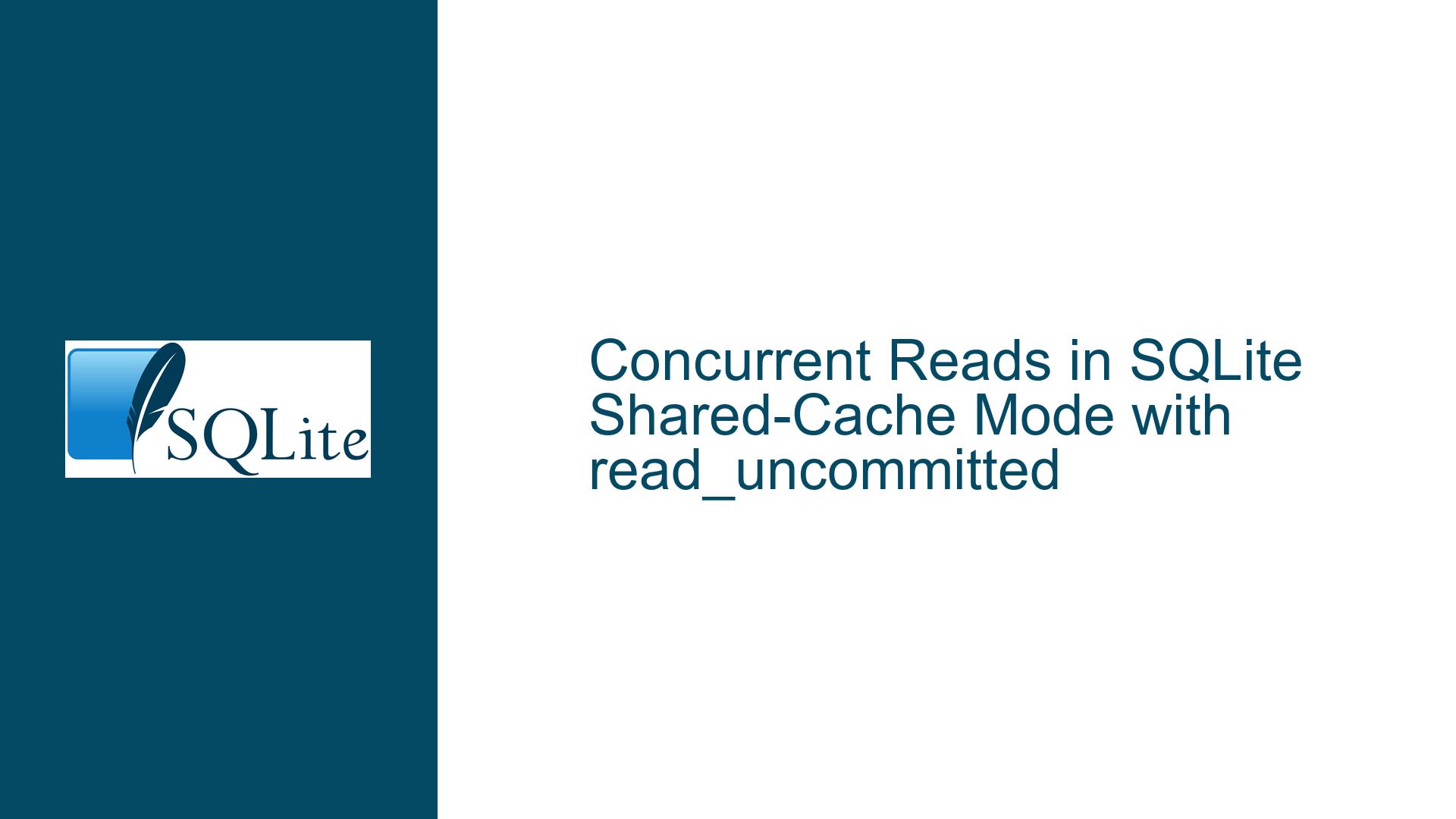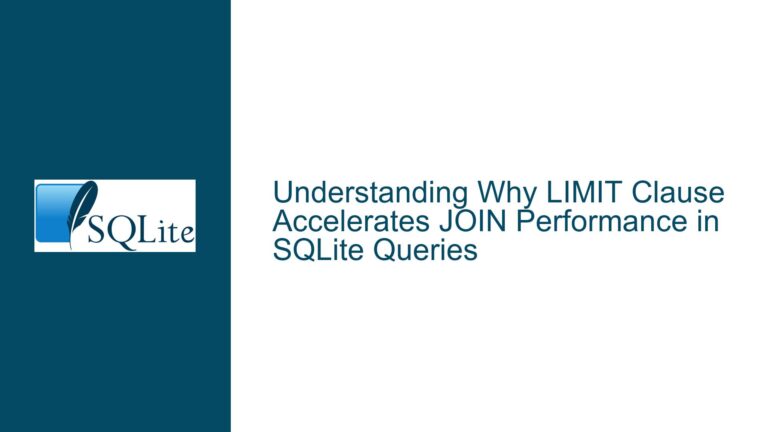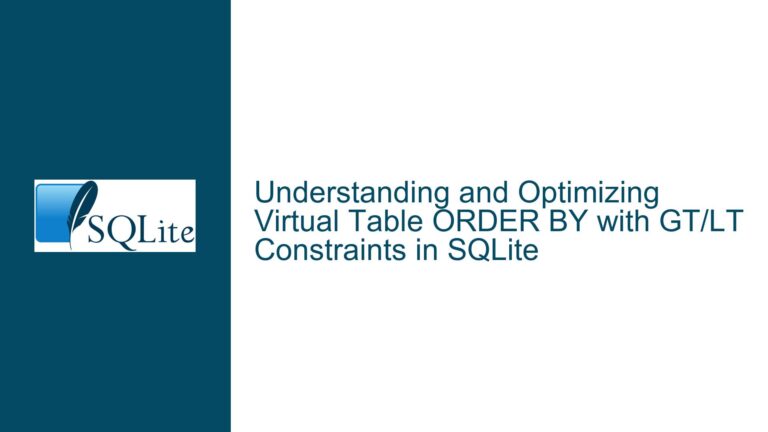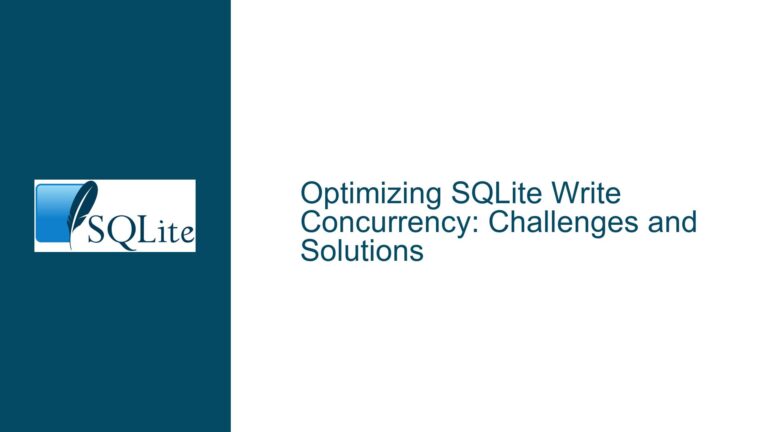Concurrent Reads in SQLite Shared-Cache Mode with read_uncommitted
Understanding Concurrent Read Behavior in Shared-Cache Mode
The core issue revolves around the interaction between SQLite’s shared-cache mode, the read_uncommitted pragma, and their combined effect on concurrent read operations. When multiple connections within the same process share a cache, SQLite employs table-level locks to manage access. The documentation states that these locks "serialize concurrent access attempts on a per-table basis," which creates ambiguity about whether concurrent reads are truly parallel or forced into serial execution. Adding the read_uncommitted pragma complicates this further, as it bypasses read-locks, raising questions about data consistency and blocking behavior.
In standard shared-cache mode without read_uncommitted, two connections reading the same table can operate concurrently if no write transaction is active. The serialization described in the documentation applies to conflicting operations (e.g., a read and a write, or two writes), not to two reads. However, the presence of a write transaction alters this behavior: readers must wait for the writer to commit or rollback. Enabling read_uncommitted removes the requirement for read-locks, allowing connections to read data even while a write transaction is in progress. This introduces the risk of reading uncommitted changes that might later be rolled back, but it eliminates blocking between readers and writers.
The confusion arises from conflating two distinct concepts:
- Locking for Conflict Resolution: Locks are primarily used to resolve conflicts between readers and writers, not to enforce serialization between readers.
- Cache Coherence: Shared-cache mode allows connections to share cached pages, but this does not inherently serialize reads; it simply reduces redundant I/O operations.
A critical oversight in interpreting the documentation is assuming that "serialize concurrent access" implies strict serial execution of all operations. In reality, SQLite uses locks to isolate transactions, not to force single-threaded access. Concurrent reads are permitted unless a write is occurring, in which case lock acquisition determines execution order.
Root Causes of Read Serialization and Locking Conflicts
Three primary factors contribute to misunderstandings about concurrent reads in shared-cache mode:
Misinterpretation of Table-Level Locking Granularity
SQLite uses table-level locks in shared-cache mode, not row-level or page-level locks. When a connection begins a write transaction, it acquires a reserved lock on the table, blocking other writers but allowing readers to proceed if they can access a consistent snapshot. However, if a reader attempts to acquire a read-lock while a writer holds a reserved lock, the reader must wait unlessread_uncommittedis enabled. The documentation’s phrasing about "serializing access" refers to the atomicity of lock acquisition, not a global mutex on the table.read_uncommitted Bypassing Lock Acquisition
Theread_uncommittedpragma disables read-lock acquisition, allowing connections to read data without checking for pending write transactions. This creates two scenarios:- No Active Writer: Concurrent reads proceed without contention.
- Active Writer: Readers see uncommitted changes, risking dirty reads.
However, this does not eliminate all forms of blocking. For example, if a writer holds an exclusive lock (during a commit), even
read_uncommittedconnections must wait for the lock to release before accessing the updated pages.Shared-Cache Mode Assumptions
Shared-cache mode is often misunderstood as a "thread-safe" or "high-concurrency" configuration. In reality, it is designed for memory-constrained environments where multiple connections within the same process can share a common cache. While it reduces memory overhead, it introduces finer-grained locking semantics. Developers expecting multi-threaded readers to execute in parallel without regard for transactional boundaries will encounter unexpected blocking if writes occur intermittently.
A practical example:
- Connection A (Write): Begins a transaction, modifies Table X, but has not yet committed.
- Connection B (Read): Attempts to read Table X.
- Without
read_uncommitted: Connection B waits for Connection A’s transaction to complete. - With
read_uncommitted: Connection B reads the uncommitted changes from Connection A.
- Without
The critical takeaway is that read_uncommitted does not enable "faster" reads in the absence of writes; it alters how readers interact with ongoing write transactions.
Resolving Shared-Cache Concurrency and read_uncommitted Misconfigurations
Step 1: Verify Locking Configuration and Isolation Levels
Begin by auditing the current configuration:
- Confirm shared-cache mode is enabled with
PRAGMA shared_cache=1(or via the URI parametercache=shared). - Check the
read_uncommittedsetting for all connections:PRAGMA read_uncommitted.
Isolation levels in SQLite are implicitly defined by transactional behavior. read_uncommitted effectively sets the isolation level to "Read Uncommitted," whereas the default is "Serializable." Ensure that all connections explicitly set read_uncommitted if dirty reads are acceptable.
Step 2: Analyze Active Transactions and Lock States
Use SQLite’s sqlite3_txn_state() API or diagnostic PRAGMAs to monitor transaction states:
PRAGMA lock_status: Shows current locks held by the database connection.PRAGMA data_version: Indicates changes to the database file; a changing value suggests writes are occurring.
If readers are blocking despite read_uncommitted, check for exclusive locks (e.g., during checkpointing or schema changes). Exclusive locks cannot be bypassed, even with read_uncommitted.
Step 3: Reproduce Concurrency Scenarios in a Controlled Environment
Simulate the following scenarios to observe behavior:
Two Readers, No Writers
- Expected: Both readers proceed concurrently.
- Actual: If serialization occurs, investigate other locks (e.g., schema locks).
Reader and Writer, read_uncommitted Disabled
- Expected: Reader blocks until writer commits.
- Actual: Use timeouts (
busy_timeout) to detect blocking.
Reader and Writer, read_uncommitted Enabled
- Expected: Reader sees uncommitted data; no blocking.
- Actual: Verify data consistency after writer rollback.
Step 4: Implement Best Practices for Shared-Cache Mode
- Avoid Shared-Cache Mode Unless Necessary: It adds complexity and is rarely required for modern applications. Use WAL mode or in-memory databases for better concurrency.
- Use read_uncommitted Sparingly: Only enable it for read-only connections that tolerate dirty reads (e.g., analytics).
- Coordinate Writes Explicitly: Use application-level locks or queues to serialize write transactions, minimizing their overlap with reads.
- Monitor for Busy Errors: Set
busy_timeoutto handle transient lock contention gracefully.
Step 5: Address Legacy RW-LOCK Patterns
If migrating from a custom RW-LOCK system, replace it with SQLite’s transactional controls:
- Write Transactions: Use
BEGIN IMMEDIATEto acquire a reserved lock early. - Read Transactions: Use
BEGIN DEFERREDand avoid long-running read transactions that block writers.
Final Recommendation
For most applications, shared-cache mode and read_uncommitted introduce more pitfalls than benefits. Prefer WAL mode with write-ahead logging, which allows concurrent reads and writes without dirty reads. Reserve shared-cache for specialized use cases, such as embedded systems with strict memory constraints.
This guide provides a comprehensive framework for diagnosing and resolving concurrency issues in SQLite’s shared-cache mode, emphasizing the interplay between locking, isolation levels, and cache management. By methodically verifying configurations, analyzing locks, and adhering to best practices, developers can avoid common pitfalls and achieve robust concurrency behavior.






